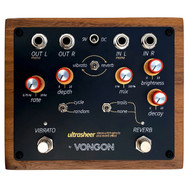Ultrasheer - Vongon
by Ellison Wolf
Fans of the 80s movie Raiders of the Lost Ark will surely remember the scene where after a pretty arduous journey through the desert to find the lost ark of the covenant, the lid is finally opened, and after 1000s of years human eyes once view into the mythical artifact and see the contents inside. In the movie there is an ethereal glow emanating from the ark, and everyone standing around is bug eyed in anticipation, ensconced in a layer of sweat, and ecstatic in the situation. Granted, they don’t know they’re about to be liquified like the contents of a green smoothie, but that’s neither here nor there. I bring this up because when I opened the cardboard box that contained Vongon’s Ultrasheer, their new stereo pitch vibrato reverb effect pedal, there was no illumination, and luckily I did not melt unto myself, but the anticipation of what was inside was still very palpable. I’d seen a few photos of the pedal online and I kept thinking that if it sounded half as good as it looked, it was sure to be one incredible pedal, one perhaps worthy of a venture into a vast scalding desert, overgrown jungle, or at the very least the jungly desert known as the internet, in order to secure one. It most definitely is a gorgeous entity, with its hand polished single block walnut enclosure, attractive faceplate, genuine USA made Rogan knobs, and quiet soft switches. After using it for a while, I can tell you that in this case beauty is much more than skin, or rather, faceplate deep. And you won’t melt when you look at it, though your mind might do a little melting, depending on your mental state.
The combination of vibrato + reverb is a classic pairing found on a lot of 70s Fender guitar amps, though Ultrasheer is not that. With the reverb being modeled after the classic Lexicon 224 reverb unit of the late 70s, and the vibrato being a digital pitch shifter the doesn’t alter the sound—so do not confuse this with tremolo, sometimes mistakenly called vibrato [I’m looking at you Fender]—Ultrasheer offers up lush, fluid warbles that will have you reminiscing about some cherished 4 am late night escapade of years [many, many years] gone by, all the way to that short, stark non-reverb tank you once spent a [ahem] few hours in, after another 4am late night escapade that didn’t turn out quite so well, and one that wasn’t quite as many, many years ago as you’d like. Sometimes it’s best to let go and move on, however in the case of the reverb, I’m glad Vongon hasn’t let go, and indeed has held on. There’s a reason the 224 is revered, and maybe it’s just nostalgia at being an early digital reverb, but no matter, this is a great sounding verb, both in modular world, and guitar world, where I gave Ultrasheer a test run. The combination of the two effects is what really makes Ultrasheer special.
I know, you’re thinking that you have your behemoth guitar pedalboard that’s the size of a NY rent-controlled apartment that can do that, plus loop, plus distortion, plus fuzz, plus 29 different delays, plus...Honestly, I hate those pedals. I really do. Been there done that, and am done with that. One of the things I like so much about Ultrasheer is the lack of options. Two effects, two sounds, it’s up to you to use it wisely and make it worth its weight in walnut. [Whew!]
The controls on Ultrasheer are straightforward and uncluttered. It has ¼” inputs for L and R, L and R outputs, for various mono/stereo configurations, and the pedal automatically adjusts its input/output configuration via some digital processing magic depending on what’s plugged into it, a nice touch. For the reverb, there is a MIX knob, a BRIGHTNESS control, a DECAY control, and a toggle for TRAILS on or off.
The Vibrato has a 0.75 Hz-10Hz rate knob, a 0-10 depth knob, and a toggle to switch between the modulation waveforms that are available; “Cycle” for classic rotary speaker emulation, and “random”, a smoothed sample-and-hold waveform that will warble the pitch the way an old cassette can do.
One thing I was really pleased about was the addition of a toggle to switch between having the reverb flow into the vibrato, and the other way around. The change is sonics is noticeable, and even though it’s pretty standard for compromises to be made in ensemble effects pedals, it’s great that this is not one of those. Sometimes I really want to hear what one pedal going into another will sound like, but don’t feel like rearranging my pedals to try it out [sue me, I’m busy!], and being able to switch between the two flows is much appreciated.
As for the technicalities of the sound [I’ve already discussed how beautiful it sounds], it employs 32 bit floating point DSP [minus a 16 bit vintage reverb algorithm] with 24 bit/48 kHz digital converters, but I don’t care if it uses two tin cans and ten feet of twine, so long as it sounds good, and Ultrasheer definitely does that.
This isn’t the pedal you’re going to velcro to your Pedaltrain Boho Jr. or a homebrew plank job with some invention your uncle came up with for adhesion. You’d also be best advised not to bury this in some far off sandpit. Rather, those with glass cabinets holding their most precious possessions, their Fabergé Eggs, vintage Patek Phillippe wristwatches, first run Klon Centaur “Professional”, etc., should find a place for Ultrasheer to take its rightful place on the shelf. However, make sure the key is handy, because you’ll actually want to use this pedal a lot, not just look at it to admire its beauty. Though stare and admire away. I can assure you, I have done just that, and have yet to melt.
Price: $419


